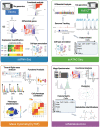Rewiring mitochondrial metabolism to counteract exhaustion of CAR-T cells
- PMID: 35346311
- PMCID: PMC8960222
- DOI: 10.1186/s13045-022-01255-x
Rewiring mitochondrial metabolism to counteract exhaustion of CAR-T cells
Abstract
Short persistence and early exhaustion of T cells are major limits to the efficacy and broad application of immunotherapy. Exhausted T and chimeric antigen receptor (CAR)-T cells upregulate expression of genes associated with terminated T cell differentiation, aerobic glycolysis and apoptosis. Among cell exhaustion characteristics, impaired mitochondrial function and dynamics are considered hallmarks. Here, we review the mitochondrial characteristics of exhausted T cells and particularly discuss different aspects of mitochondrial metabolism and plasticity. Furthermore, we propose a novel strategy of rewiring mitochondrial metabolism to emancipate T cells from exhaustion and of targeting mitochondrial plasticity to boost CAR-T cell therapy efficacy.
Keywords: CAR-T cell exhaustion; Metabolism; Mitochondria; Single-cell techniques.
© 2022. The Author(s).
Conflict of interest statement
The authors declare no competing financial interests.
Figures



Similar articles
-
Deletion of Cbl-b inhibits CD8+ T-cell exhaustion and promotes CAR T-cell function.J Immunother Cancer. 2021 Jan;9(1):e001688. doi: 10.1136/jitc-2020-001688. J Immunother Cancer. 2021. PMID: 33462140 Free PMC article.
-
Mathematical deconvolution of CAR T-cell proliferation and exhaustion from real-time killing assay data.J R Soc Interface. 2020 Jan;17(162):20190734. doi: 10.1098/rsif.2019.0734. Epub 2020 Jan 15. J R Soc Interface. 2020. PMID: 31937234 Free PMC article.
-
Secretion of human soluble programmed cell death protein 1 by chimeric antigen receptor-modified T cells enhances anti-tumor efficacy.Cytotherapy. 2020 Dec;22(12):734-743. doi: 10.1016/j.jcyt.2020.05.007. Epub 2020 Jul 17. Cytotherapy. 2020. PMID: 32684339
-
Chimeric Antigen Receptor T Cell Exhaustion during Treatment for Hematological Malignancies.Biomed Res Int. 2020 Oct 23;2020:8765028. doi: 10.1155/2020/8765028. eCollection 2020. Biomed Res Int. 2020. PMID: 33150182 Free PMC article. Review.
-
Metabolic plasticity and regulation of T cell exhaustion.Immunology. 2022 Dec;167(4):482-494. doi: 10.1111/imm.13575. Epub 2022 Sep 30. Immunology. 2022. PMID: 36088582 Review.
Cited by
-
Advanced Strategies of CAR-T Cell Therapy in Solid Tumors and Hematological Malignancies.Recent Pat Anticancer Drug Discov. 2024;19(5):557-572. doi: 10.2174/0115748928277331231218115402. Recent Pat Anticancer Drug Discov. 2024. PMID: 38213150 Review.
-
Targeting mitochondria: restoring the antitumor efficacy of exhausted T cells.Mol Cancer. 2024 Nov 19;23(1):260. doi: 10.1186/s12943-024-02175-9. Mol Cancer. 2024. PMID: 39563438 Free PMC article. Review.
-
Unraveling the roles and mechanisms of mitochondrial translation in normal and malignant hematopoiesis.J Hematol Oncol. 2024 Oct 12;17(1):95. doi: 10.1186/s13045-024-01615-9. J Hematol Oncol. 2024. PMID: 39396039 Free PMC article. Review.
-
CAR-T cell therapy: Advances in digestive system malignant tumors.Mol Ther Oncol. 2024 Sep 10;32(4):200872. doi: 10.1016/j.omton.2024.200872. eCollection 2024 Dec 19. Mol Ther Oncol. 2024. PMID: 39377038 Free PMC article. Review.
-
Chimeric antigen receptor T cells in the treatment of osteosarcoma (Review).Int J Oncol. 2024 Apr;64(4):40. doi: 10.3892/ijo.2024.5628. Epub 2024 Feb 23. Int J Oncol. 2024. PMID: 38390935 Free PMC article. Review.
References
Publication types
MeSH terms
Grants and funding
LinkOut - more resources
Full Text Sources

